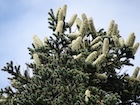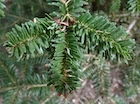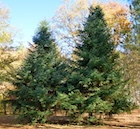
A mature tree in habitat, Algeria; iNaturalist observation 58946790 [Mehdi Chetibi, 2020.09].

Nearly-mature cones and older rachides on a tree in habitat, Algeria; iNaturalist observation 133762820 [BOULAOUAD Belkacem Aimene, 2022.09].

Foliage on a tree in habitat, Djebel Babor, Algeria; iNaturalist observation 185416972 [BOULAOUAD Belkacem Aimene, 2022.09.03].

Saplings, regenerating in habitat, Algeria; iNaturalist observation 58946823 [Mehdi Chetibi, 2020.09].

Cultivated trees at Bukreev arboretum (Adygea Republik, Russian Federation) [
Эдуард Герлах / Eduard Gerlach, 2023.11].

Conservation Status

Abies numidica
de Lannoy ex Carrière 1866
Common names
Algerian fir (Vidakovic 1991).
Taxonomic notes
Synonymy (Christensen and Orlova 2006):
- A. pinsapo Boiss. var. baborensis Cosson 1866.
- A. baborensis (Cosson) Cosson 1866;
Description
"A tree up to 25 m high. Bark grey and smooth on young trees, becoming brown-gray, scaly and fissured with age. Crown conical, densely branched. Branches horizontally spread. Shoots yellow-green to brown, glossy and glabrous. Buds ovate, large, dark-brown. not resinous or slightly resinous. Needles densely packed, on the upper side of the shoot brush-like, but along the central part of the shoot absent thus forming a V-shape, 15-20 mm long, thick, tough, flat, twisted at the base, dark green, stomata lines apically, lower surface with 2 white stomata bands. Female flowers green-yellow. Cones cylindrical, 15-20 cm long, 3.5-5.5 cm wide; seed scales cca 3 cm wide, somewhat tomentose dorsally, reflexed and with an entire margin; bract scales short, do not protrude. Seed 12-14 mm long; wing longer than the seed, 1000 seeds weigh about 70 g. Cotyledons 4-8" (Vidakovic 1991). See García Esteban et al. (2004) for a detailed characterization of the wood anatomy.
Distribution and Ecology
Algeria, "where it occupies an area on Mounts Babor and Talahor in the Kabylie range, from 1300 to 2000 m altitude. It often mingles with Quercus mirbecki, Cedrus atlantica, Taxus baccata, Ilex aquifolium and other species" (Vidakovic 1991). Hardy to Zone 6 (cold hardiness limit between -23.2°C and -17.8°C) (Bannister and Neuner 2001).
Distribution of Abies in the Mediterranean region. Data from Conifers of the World BRAHMS database, downloaded 2017.11.05. Taxa are color coded; see pull-out menu at left of map for details. Click on each occurrence for further information.
Remarkable Specimens
No data as of 2023.02.22.
Ethnobotany
"Algerian fir withstands summer drought well. Since shoots appear rather late, it is not prone to spring frost injury. Low winter temperatures and impure atmosphere can damage this fir severely. It is suited for ornamental purposes because of its luxuriant, deep green crown. It can be successfully trimmed and therefore used for hedges. It is cultivated in the Mediterranean" (Vidakovic 1991).
Observations
No data as of 2023.02.22.
Remarks
Citations
Carrière, E. A. 1866. Rev. Hort. 37:106.
Christensen, K. I. and L. V. Orlova. 2006. Typification of specific and infraspecific names in Abies, Larix, Picea,
and Pinus (Pinaceae). Feddes Repertorium 117:7-8, 519-525.
See also
The species account at Threatened Conifers of the World.
Elwes and Henry 1906-1913 at the Biodiversity Heritage Library. This series of volumes, privately printed, provides some of the most engaging descriptions of conifers ever published. Although they only treat species cultivated in the U.K. and Ireland, and the taxonomy is a bit dated, still these accounts are thorough, treating such topics as species description, range, varieties, exceptionally old or tall specimens, remarkable trees, and cultivation. Despite being over a century old, they are generally accurate, and are illustrated with some remarkable photographs and lithographs.
Farjon, Aljos. 1990. Pinaceae: drawings and descriptions of the genera Abies, Cedrus, Pseudolarix, Keteleeria, Nothotsuga, Tsuga, Cathaya, Pseudotsuga, Larix and Picea. Königstein: Koeltz Scientific Books.
- Provides a detailed account, with illustrations.
Farjon (2010).





